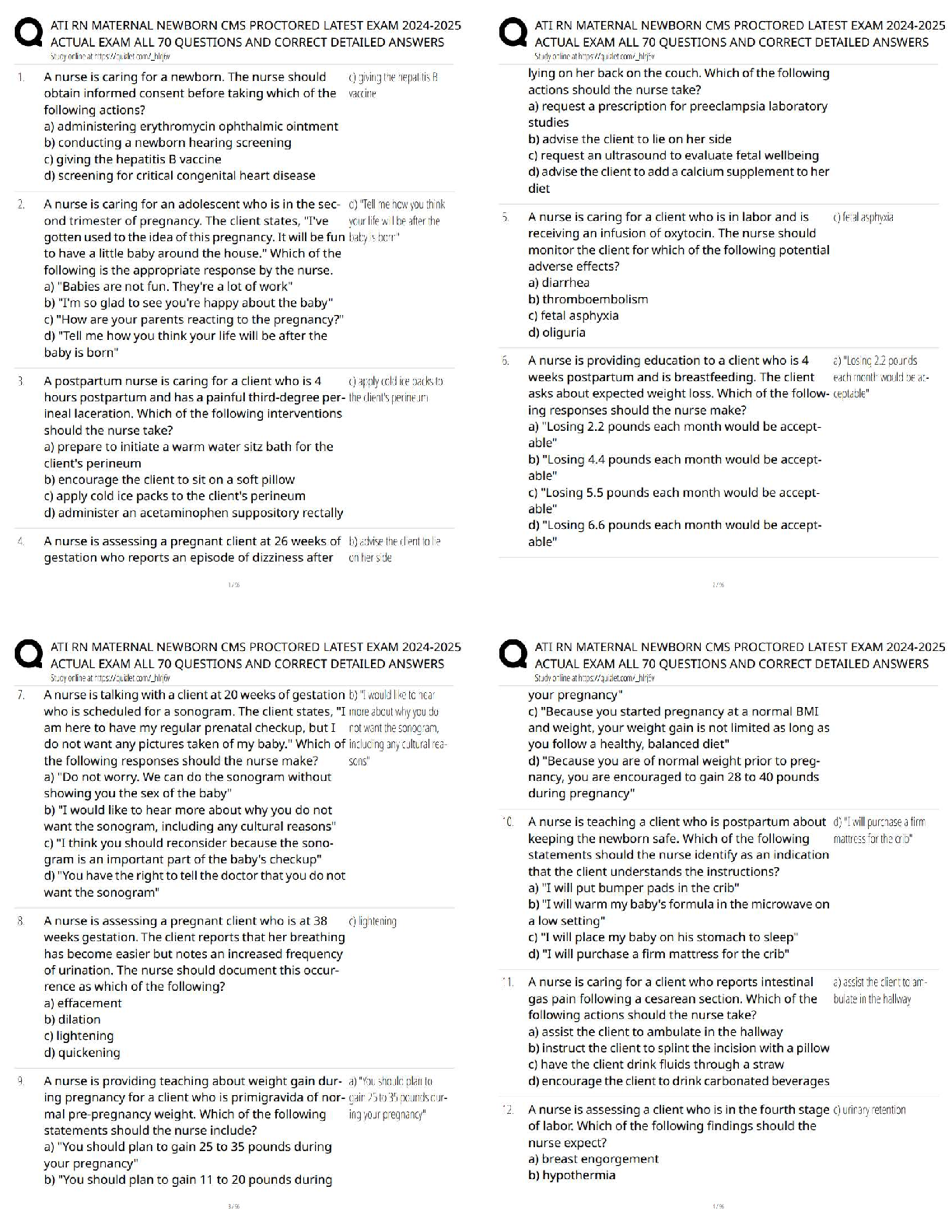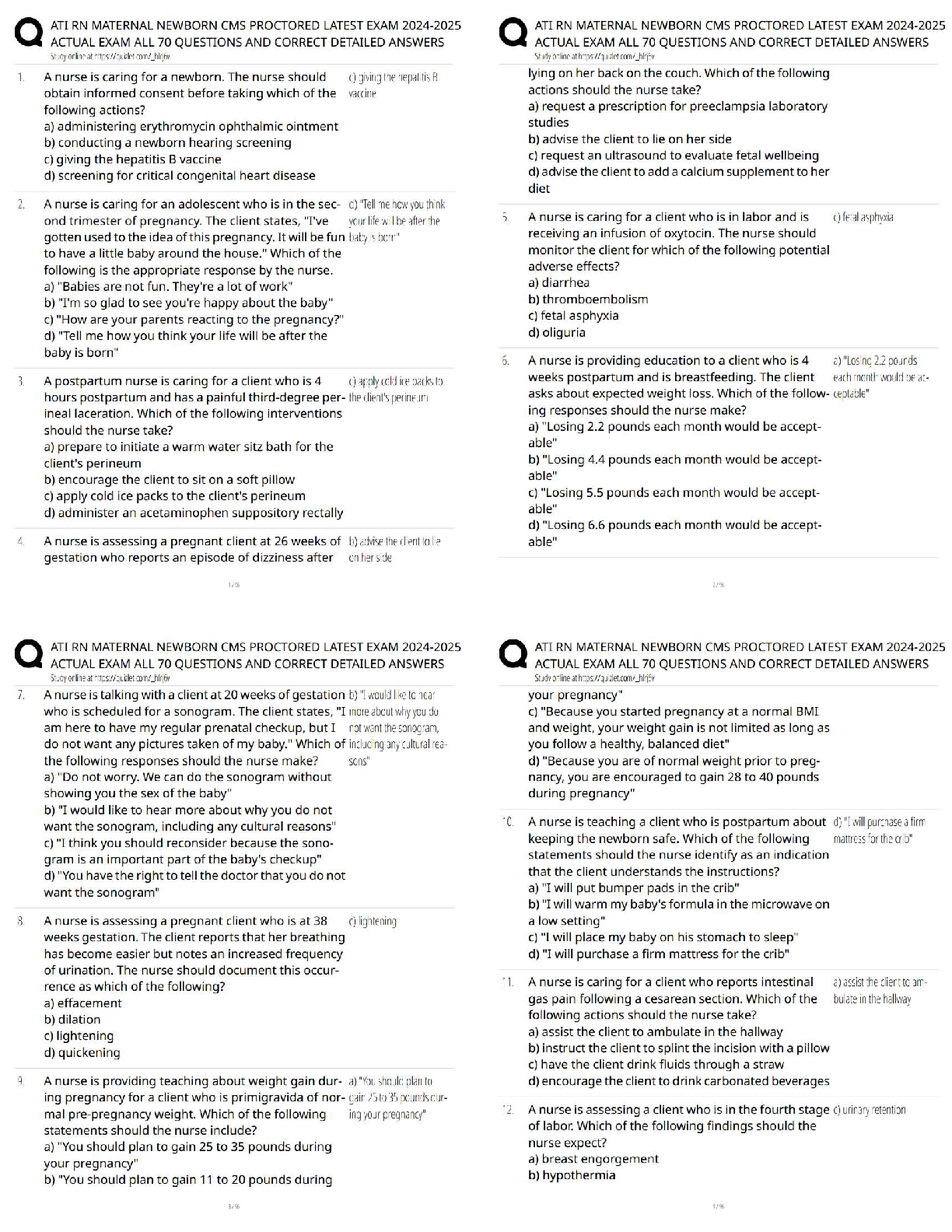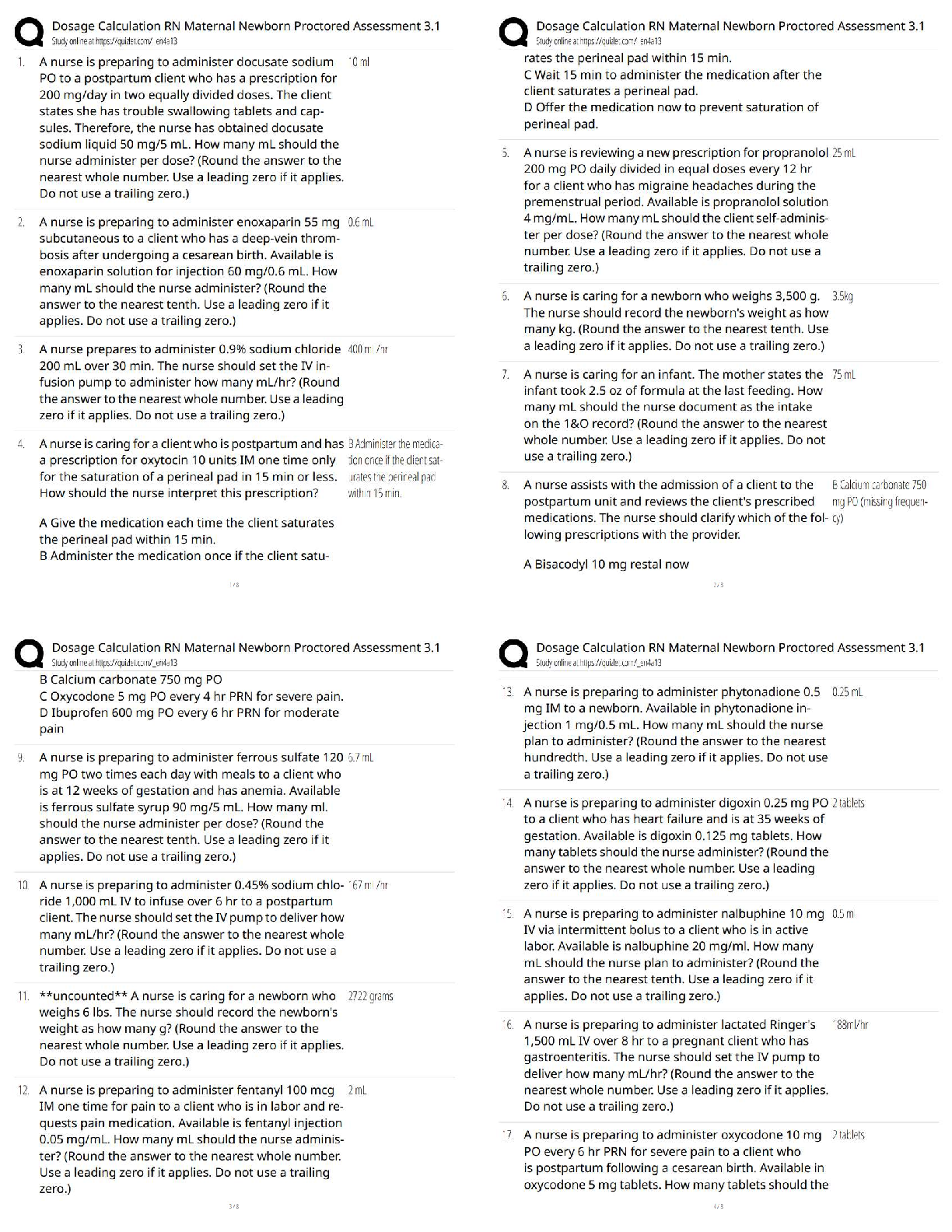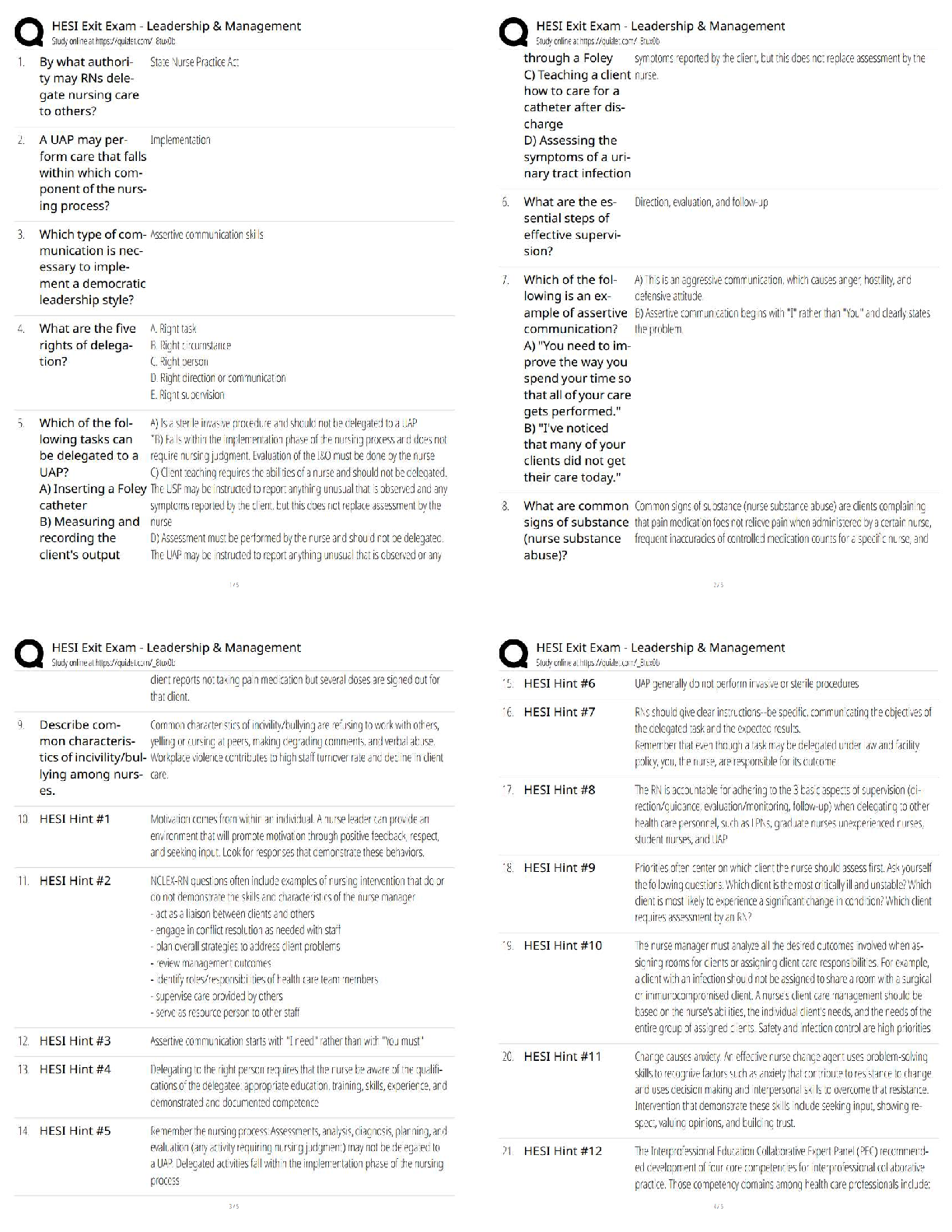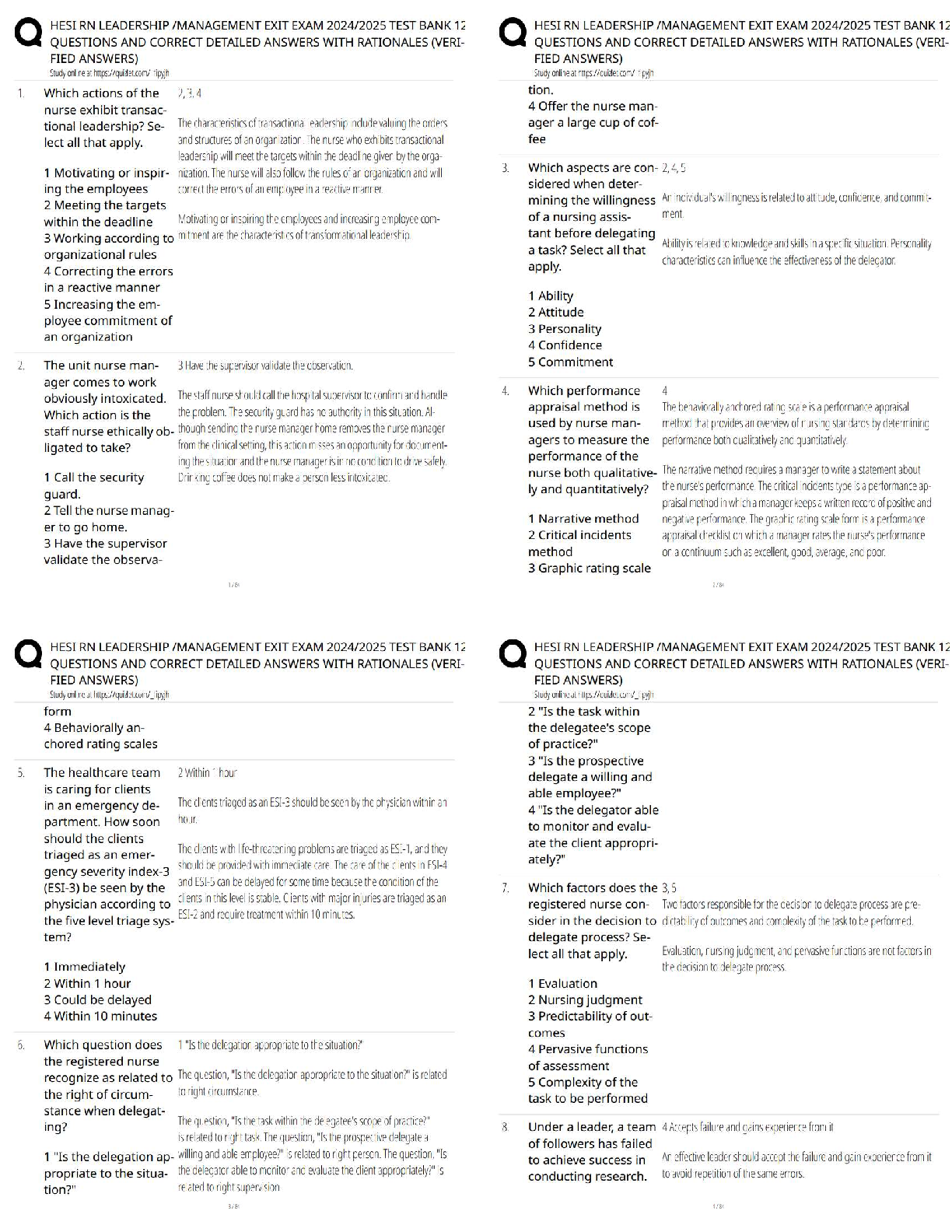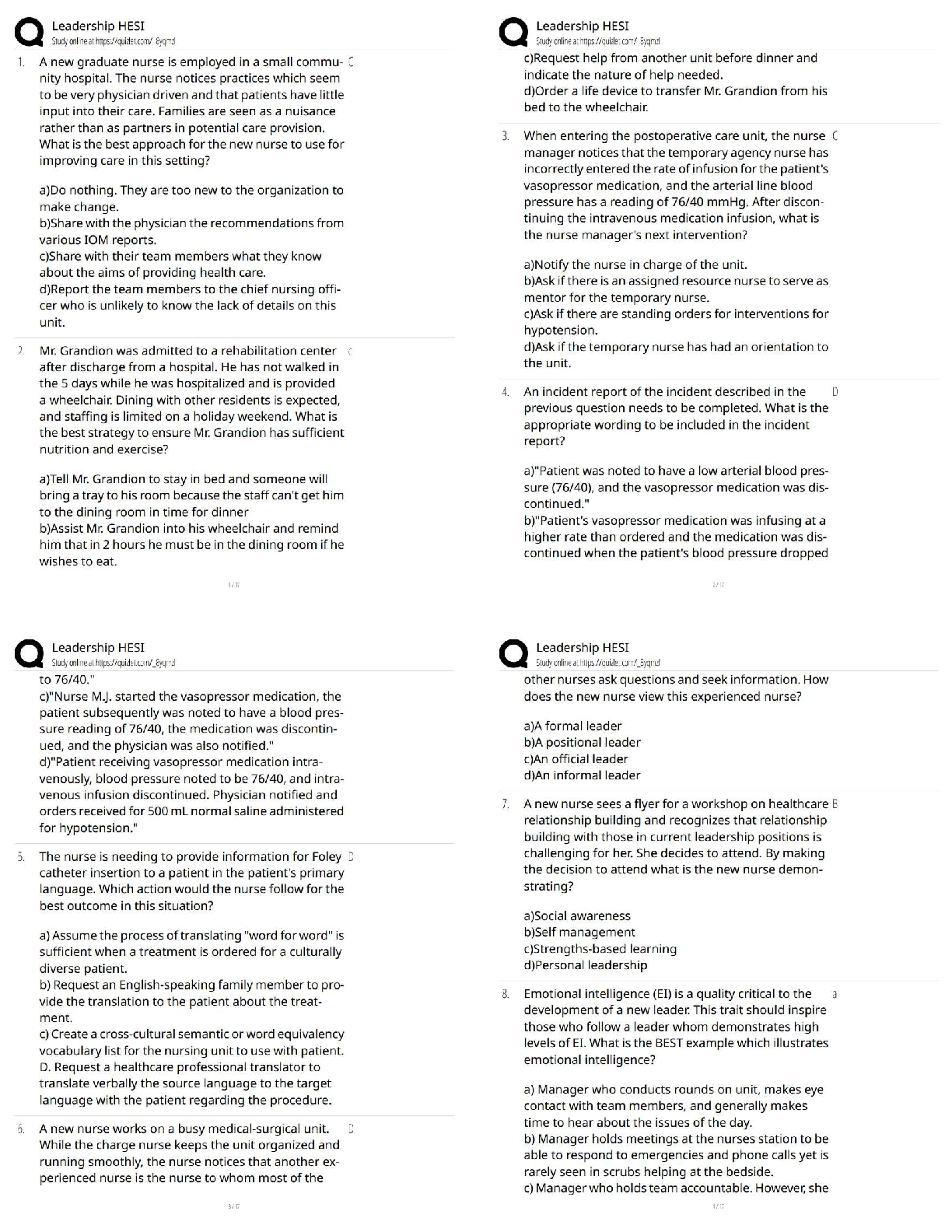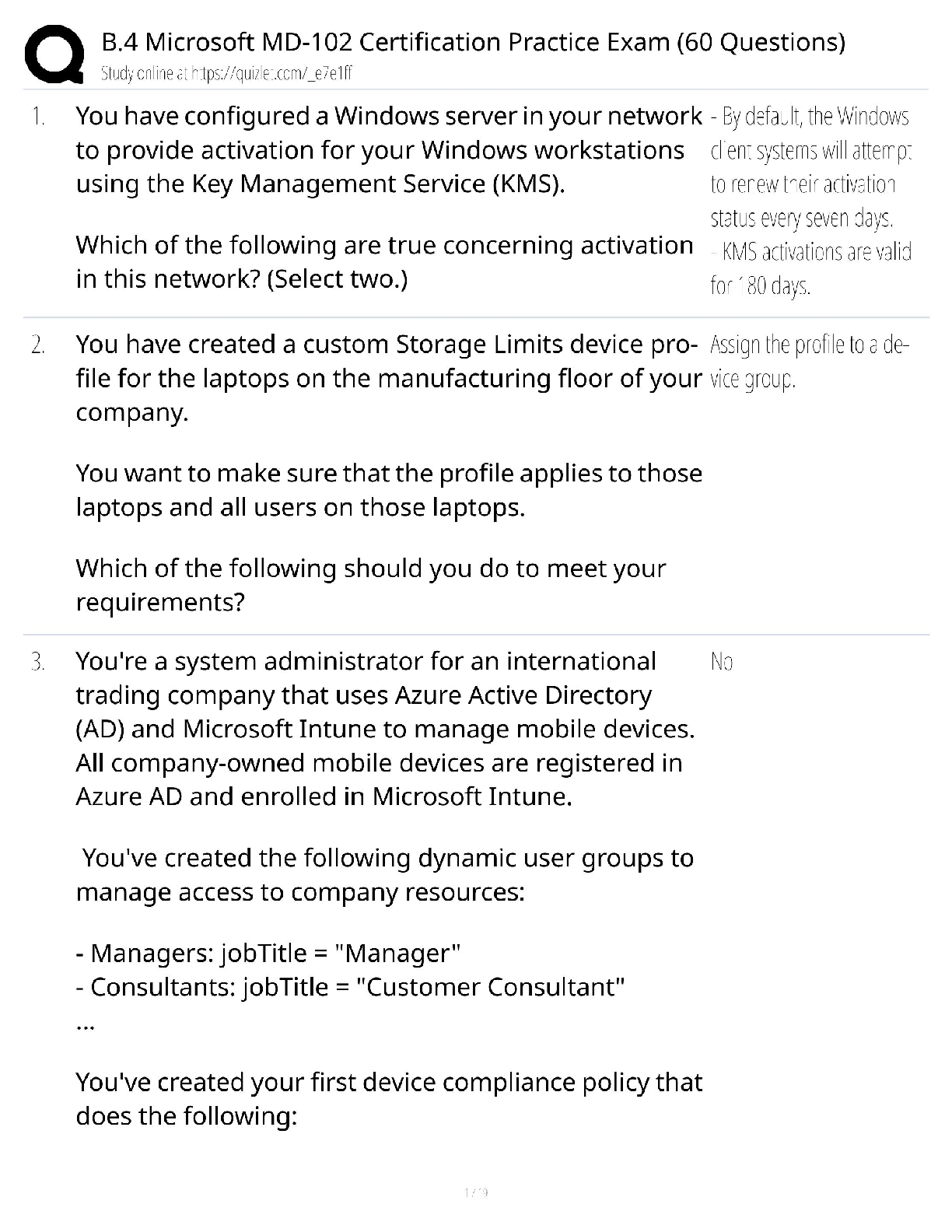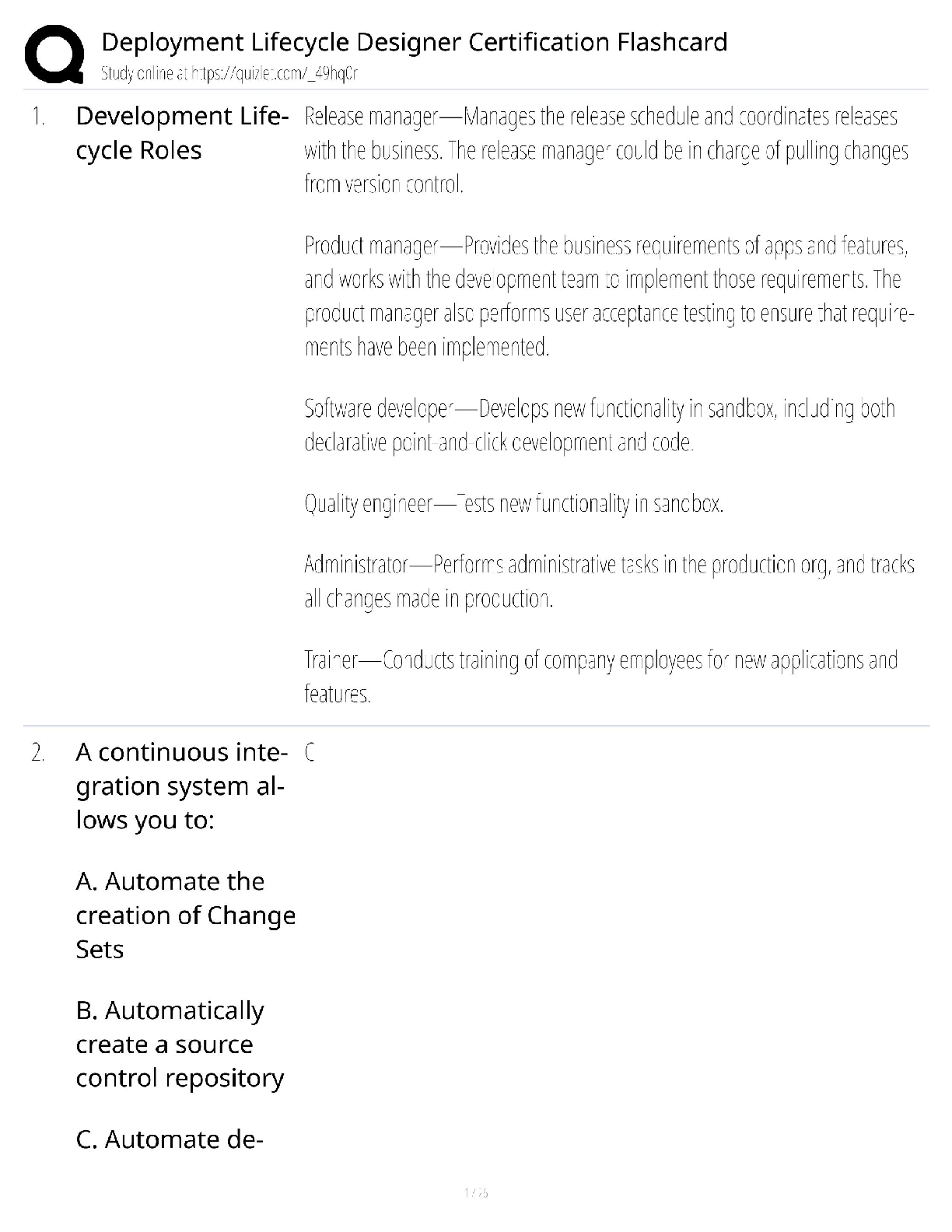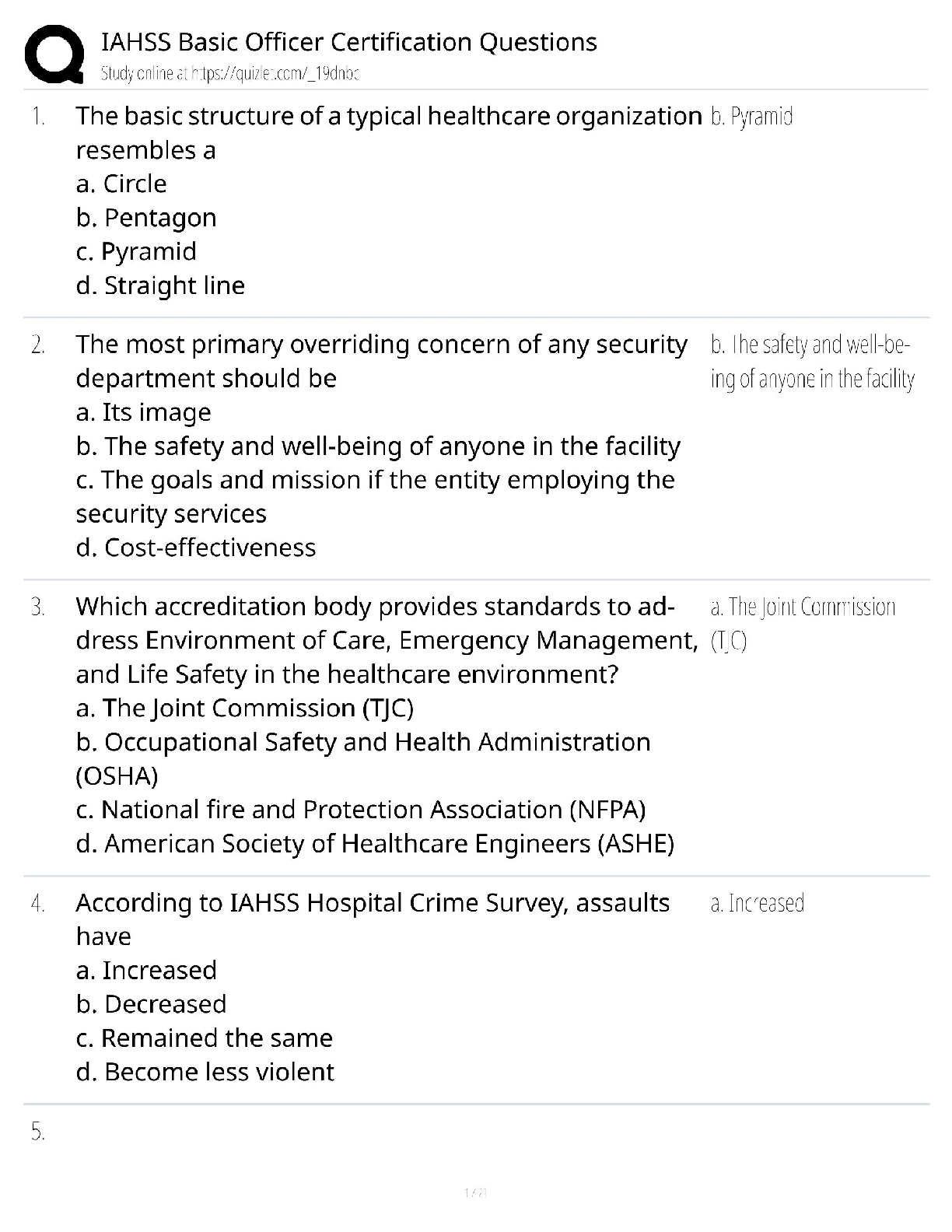*NURSING > QUESTIONS & ANSWERS > ACLS 2021, Questions with accurate answers, rated A+ (All)
ACLS 2021, Questions with accurate answers, rated A+
Document Content and Description Below
ACLS 2021, Questions with accurate answers, rated A+ Which class of medications commonly given to patients with acute coronary syndromes may be adversely affected by morphine administration A. P ... hosphodiesterase inhibitors B. Oral antiplatelet medications C. Beta blockers D. Calcium channel blockers - ✔✔Oral antiplatelet medications What is a benefit of morphine when given for the management of acute coronary syndromes? A. Central nervous system analgesia B. Increases systemic vascular resistance C. Increases left ventricular preload D. Vasoconstriction - ✔✔A. Central nervous system analgesia You obtain a 12-lead ECG in a patient with restrosternal chest pain. Which ECG finding is suggestive of high risk non ST segment elevation acute coronary syndromes A. ST depressions less than 0.5mm B. Dynamic T-wave inversion C. ST-segment elevation D. New bundle branch block - ✔✔B. Dynamic T-wave inversion Upon reviewing a patient's 12 lead ECG, you note ST-segment elevation of 2mm in leads II,III, and aVF How would you classify the electrocardiographic findings A. Normal B. STEMI C. Non-STEMI D. Non-diagnostic - ✔✔b. STEMI What happens when teams rapidly assess and intervene when patients have abnormal vital signs - ✔✔The number of in hospital cardiac arrests decreases What is the goal for first medical contact-to-ballon inflation time for a patient receiving PCI - ✔✔90 minutes What is the longest acceptable emergency department door-to-needle time when fibrinolysis is the intended reperfusion strategy - ✔✔30 minutes What is the time goal for how quickly you should complete a fibronolytic checklist once the patient arrives in the emergency department - ✔✔10 minutes What is the recommended time window after symptom onset for early fibronolytic therapy or direct catheter-based reperfusion for patients with STEMI and no contraindication - ✔✔Within 12 hours a 49 yo says that he has had chest discomfort and excessive sweating for the past 25 minutes. Within the first 10 minutes, on the basis of the patient showing symptoms suggestive of MI, what will your first actions include? - ✔✔Provide prehospital notification to the receiving hospital Administer aspirin if considering prehospital fibrinolysis, use the fibrinolytic checklist assess ABC Obtain EKG consider oxygen, nitroglycerin, and morphine if needed His initial vital signs are HR 120/min BP 135/88 RR 23 O2 87% When considering oxygen saturation, what is your course of actions? - ✔✔Start oxygen at 4L What additional questions help you determine next steps - ✔✔When did the symptoms start Do you take any medication Do you have any allergies Your patient continues to say that he has chest discomfort What treatment can you repeat as long as it is not contraindicated by vital signs - ✔✔Nitroglycerin sublingual every 3-5min What is your interpretation of the patient's EKG tracing STEMI in V2-6 - ✔✔Anterior STEMI With the possible diagnosis of STEMI, what is the most probable treatment - ✔✔Admission for PCI/fibrinolysis After you give report to the hospital, staff advise you to proceed to the cath lab for PCI What is the goal for PCI when treating this patient - ✔✔First medical contact to balloon inflation time of 90 minutes Which action is part of the secondary assessment of a conscious patient - ✔✔Formulate a differential diagnosis What is the most common type of stroke - ✔✔Ischemic stroke What is the recommended time window after symptom onset for early fibrinolytic therapy or direct catheter based reperfusion for patients with STEMI and no contraindications - ✔✔12 hours What validated, abbreviated out of hospital neurologic evaluation tool contains 3 components: facial droop, arm drift, and abormal speech test - ✔✔Cincinnati Prehospital Stroke scale What is the estimated probability of the CPSS with 1 abnormal finding when scored by prehospital providers - ✔✔72% Which is a stroke severity tool that helps EMS differentiate large vessel occlusion stroke from non-large vessel occlusion stroke - ✔✔Los Angeles Motor Scale What is the primary advantage of using a stroke severity tool? - ✔✔It helps ID large vessel occlusion stroke During CPR, CCF should be at least ______% and ideally greater than _____% - ✔✔60/80 What is an advantage of EMS alerting the receiving facility of the impending arrival of a patient with suspected acute ischemic stroke - ✔✔The hospital can perform more efficient evaluation and management What is the time goal for neurologic assessment by the stroke team or designee and noncontrast computed tomography or MRI performed after hospital arrival - ✔✔20 minutes What is the time goal for initiation of fibrinolytic therapy in appropriate patients without contraindication after hospital arrival - ✔✔45 minutes What is the door-to-needle time goal for 85% or more of acute ischemic stroke patients treated with IV thrombolytics - ✔✔60 minutes What is the door-to-device time goal for direct arriving patients with acute ischemic stroke treated with endovascular therapy - ✔✔90 minutes Evidence suggests that there is a higher likelihood of good to excellent functional outcome when alteplase is given to adults with an acute ischemic stroke within what time frame - ✔✔3 hours What is the maximum time from last known normal when endovascular therapy can be performed - ✔✔24 hours What is the max time from last known normal when intra-arterial thrombolysis for select patients can be used for treatment - ✔✔6 hours ID the SBP threshold for withholding fibrinolytic therapy to otherwise eligible patients with acute ischemic stroke - ✔✔185mmHg What is the DBP threshold for withholding fibrinolytic to otherwise eligible patients with acute ischemic stroke - ✔✔110mmHg Which action is not part of the acute stroke pathway - ✔✔Seizure prophylaxis What BG should trigger the administration of IV or subQ insulin for a patient with acute ischemic stroke - ✔✔180 A 74 yo man was brought to the hospital by his wife. She states that her husband started having sudden left arm weakness and left sided paralysis during lunch. He has a past medical history or poorly controlled hypertension HR 92 RR 14 BP 130/86 SPO2 97% Afib on monitor What additional assessment and stabilization activities should be completed? - ✔✔Establish time of symptom onset (last known normal) perform validated prehospital stroke screen and stroke severity tool provide prehospital notification to the receiving hospital initiate stroke protocol check glucose What needs to be completed for this patient within 20 min after hospital arrival - ✔✔neurologic assessment what are some of the general questions you need to ask - ✔✔when did the symptoms start do you have any allergies do you take any medications what other symptoms do you have within 45 minutes, the neuroimaging interpretation of the CT scan of the brain suggests an acute ischemic infarction. There is no signs of hemorrhage or mass lesions Is this patient a potential candidate for fibrinolytic therapy? - ✔✔Yes What actions should the hospital staff take to determine whether the patient is a candidate for fibrinolytic therapy - ✔✔Repeat neurologic exam You find that the patient's neurologic function is rapidly improving. Is this patient still a candidate for fibrinolytic therapy? - ✔✔No Because the patient is no longer a candidate for fibrinolyic therapy, what are your next steps for him? - ✔✔Support ABC Begin stroke pathway Admit to ICU What tidal volume typically maintains normal oxygenation and elimination of carbon dioxide - ✔✔6-8mL/kg an 18yo is reporting difficulty breathing and is displaying increased respiratory effort b/l wheeze RR 28 O2 91% PETCO2 44mmHg - ✔✔Respiratory distress a 59yo is reporting difficulty breathing nasal flaring, intercostal retractions, and use of accessory muscles RR 28 O2 92% PETCO2 36mmHg - ✔✔Respiratory distress 75yo patient difficulty breathing emphysema drowsy b/l wheeze, difficult to appreciate RR 38 O2 85% PETCO2 49mmHg - ✔✔Respiratory failure What is the term for the rise in arterial carbon dioxide levels typically associated with respiratory failure - ✔✔hypercapnia How much tidal volume must you provide with a bag mask device to produce visible chest rise for an adult patient in respiratory arrest - ✔✔6-7mL/kg What device on a resuscitation bag mask device may prevent sufficient tidal volume in patients with poor lung compliance - ✔✔pressure relief valve patients with perfusing rhythms should receive ventilation once every _____ seconds - ✔✔6 What is the most effective way to deliver bag mask ventilation - ✔✔2 person technique how long should the second rescuer squeeze the bag mask device when providing 2 rescuer ventilation - ✔✔1 second [Show More]
Last updated: 3 years ago
Preview 1 out of 22 pages

Buy this document to get the full access instantly
Instant Download Access after purchase
Buy NowInstant download
We Accept:

Also available in bundle (2)
Click Below to Access Bundle(s)
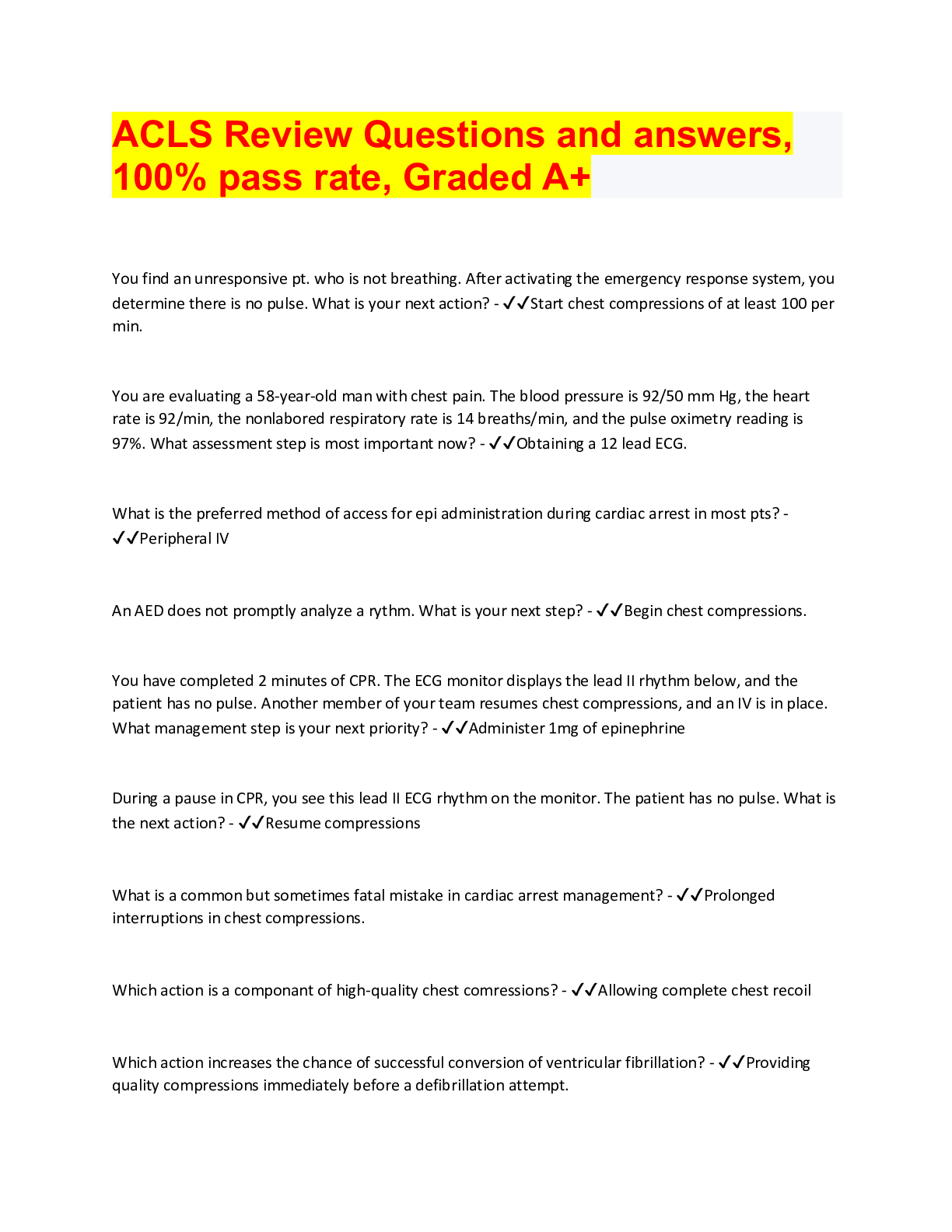
ACLS BUNDLE, EXAM QUESTIONS AND ANSWERS, RATED A
All ACLS exam questions with answers, download to score A+
By bundleHub Solution guider 3 years ago
$30
7

ACLS EXAM BUNDLE
Questions and answers, masterpieces, predictor papers, download to score
By bundleHub Solution guider 3 years ago
$38
10
Reviews( 0 )
$12.00
Can't find what you want? Try our AI powered Search
Document information
Connected school, study & course
About the document
Uploaded On
Aug 21, 2022
Number of pages
22
Written in
All
Seller

Reviews Received
Additional information
This document has been written for:
Uploaded
Aug 21, 2022
Downloads
0
Views
158













